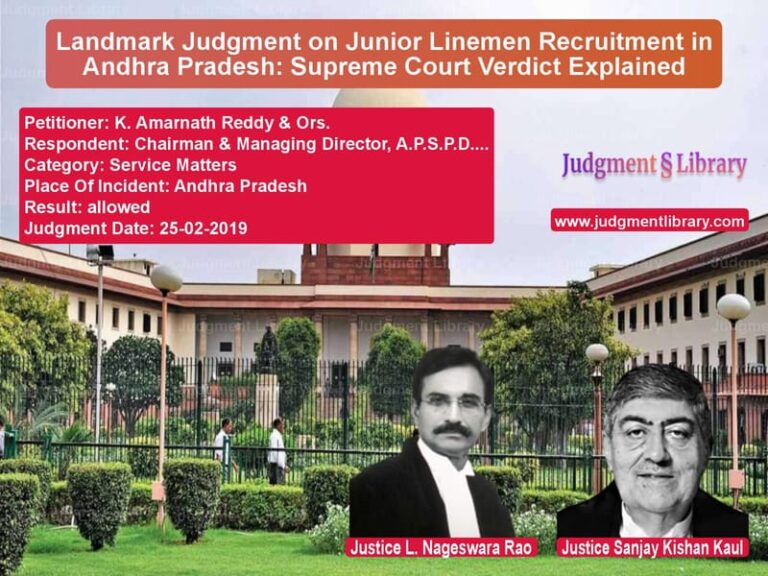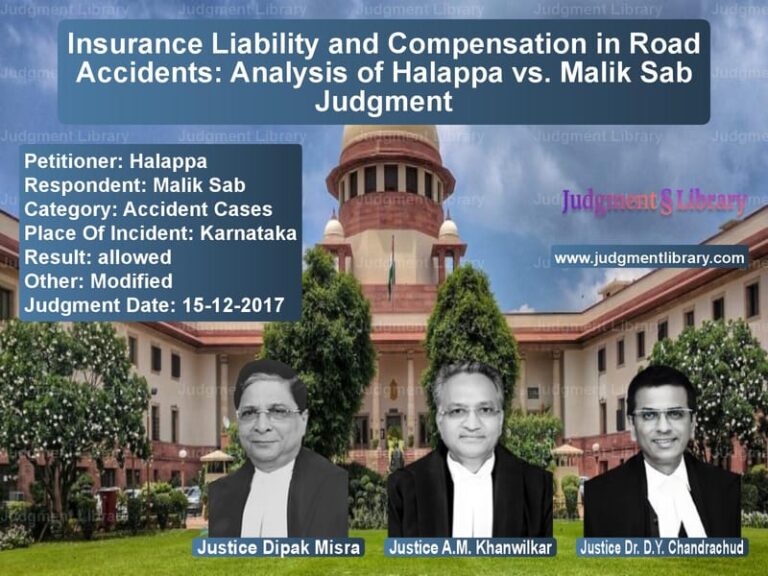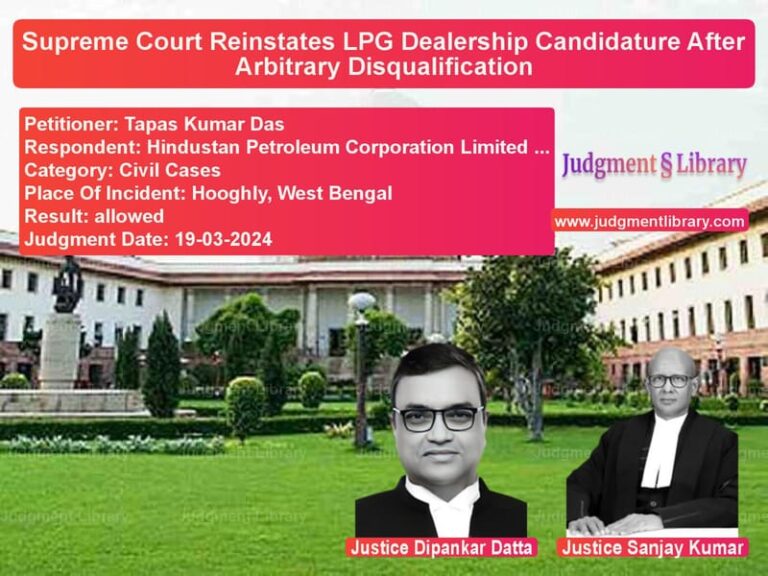Supreme Court Calls for Guidelines on Mitigating Factors in Death Penalty Cases
The imposition of the death penalty in India has long been a subject of judicial scrutiny, particularly in light of the “rarest of rare” doctrine established in Bachan Singh v. State of Punjab. Over the years, courts have been divided on the necessity of conducting a separate hearing on sentencing after conviction. Recognizing these inconsistencies, the Supreme Court took suo motu cognizance of the issue, resulting in the case In Re: Framing Guidelines Regarding Potential Mitigating Circumstances to be Considered While Imposing Death Sentences. This case seeks to establish uniform guidelines for considering mitigating factors before imposing capital punishment.
Background of the Case
The Supreme Court initiated this suo motu writ petition due to differing judicial approaches on whether a separate hearing must be conducted after conviction in death penalty cases. The case examines the legal mandate under Section 235(2) of the Code of Criminal Procedure (CrPC), which requires courts to hear the accused before sentencing.
Section 235(2) of the CrPC states:
“If the accused is convicted, the Judge shall, unless he proceeds in accordance with the provisions of Section 360, hear the accused on the question of sentence, and then pass sentence on him according to law.”
The Supreme Court noted that despite the statutory requirement, the extent and manner of compliance varied across cases, leading to uncertainty in sentencing procedures.
Judicial Precedents on the Issue
1. Bachan Singh v. State of Punjab (1980)
The landmark judgment in Bachan Singh upheld the constitutional validity of the death penalty but limited its application to the “rarest of rare” cases. The judgment underscored the importance of a separate sentencing hearing, allowing the accused to present mitigating factors.
2. Santa Singh v. State of Punjab (1976)
In this case, the Court emphasized the necessity of a bifurcated trial, where the sentencing process is distinct from the determination of guilt. It observed:
“The sentencing judge must make a genuine effort to elicit from the accused all information that will bear on the question of sentence.”
3. Allauddin Mian v. State of Bihar (1989)
The Supreme Court reiterated that sentencing should not be treated as a mere formality and that courts must allow the accused to present mitigating circumstances.
4. Manoj v. State of Madhya Pradesh (2022)
In Manoj, the Court noted that sentencing in death penalty cases often lacks comprehensive background information on the accused. It suggested developing a uniform framework for considering mitigating factors.
Read also: https://judgmentlibrary.com/supreme-court-acquits-woman-convicted-of-poisoning-daughter/
Issues Before the Court
The Supreme Court identified several concerns:
- Should a separate hearing on sentencing be mandatory in death penalty cases?
- What are the relevant mitigating factors that must be considered before imposing the death penalty?
- How can courts ensure that the accused has a meaningful opportunity to present mitigating circumstances?
Arguments by the Petitioner (Suo Motu Cognizance)
The Supreme Court, acting on its own initiative, highlighted the inconsistencies in sentencing practices. It observed that:
- There is no uniform approach across different courts regarding the hearing on sentencing.
- In some cases, sentencing occurs on the same day as conviction, denying the accused a fair opportunity to present mitigating factors.
- The absence of guidelines results in arbitrary imposition of the death penalty.
Arguments by the Respondents
The State argued that:
- The existing legal framework under the CrPC and previous judgments provide sufficient safeguards.
- Mandating a separate sentencing hearing may prolong trials and lead to unnecessary delays.
- Courts already have the discretion to consider mitigating factors, and a rigid framework may not be necessary.
Supreme Court’s Observations
The bench, comprising Chief Justice Uday Umesh Lalit, Justice S. Ravindra Bhat, and Justice Sudhanshu Dhulia, made the following observations:
1. Importance of a Separate Sentencing Hearing
The Court emphasized that sentencing should not be a mere formality. It stated:
“A meaningful opportunity must be given to the accused to present mitigating circumstances before the court decides on the imposition of the death penalty.”
2. Need for a Uniform Framework
The Court noted that mitigating factors such as mental health, socioeconomic background, and post-conviction behavior should be systematically considered.
3. Judicial Prudence in Sentencing
Quoting earlier judgments, the Court stressed:
“The balance between aggravating and mitigating circumstances must be carefully weighed to ensure that the death penalty is imposed only in the rarest of rare cases.”
Final Judgment
The Supreme Court referred the matter to a larger bench of five judges for further deliberation, stating:
“Given the conflicting judicial opinions and the absence of clear guidelines, a larger bench must determine the framework for considering mitigating factors in death penalty cases.”
Implications of the Judgment
This case is significant for several reasons:
1. Ensuring Fairness in Capital Sentencing
The ruling highlights the importance of procedural fairness, ensuring that accused persons receive a genuine opportunity to present mitigating factors.
2. Preventing Arbitrary Death Sentences
By establishing clear guidelines, the judgment seeks to prevent arbitrary and inconsistent application of the death penalty.
3. Strengthening Human Rights Protections
The case aligns with international human rights principles that advocate for stringent safeguards in capital punishment cases.
Conclusion
The Supreme Court’s decision to refer the matter to a larger bench marks a crucial step in reforming India’s death penalty jurisprudence. By advocating for a structured approach to sentencing, the Court aims to ensure that capital punishment is imposed only in the most exceptional circumstances. The forthcoming judgment by the larger bench will have far-reaching implications for India’s criminal justice system, potentially leading to a more consistent and humane approach to sentencing in death penalty cases.
Petitioner Name: Suo Motu Writ Petition.Respondent Name: State & Anr..Judgment By: Justice Uday Umesh Lalit, Justice S. Ravindra Bhat, Justice Sudhanshu Dhulia.Place Of Incident: India.Judgment Date: 19-09-2022.
Don’t miss out on the full details! Download the complete judgment in PDF format below and gain valuable insights instantly!
Download Judgment: suo-motu-writ-petiti-vs-state-&-anr.-supreme-court-of-india-judgment-dated-19-09-2022.pdf
Directly Download Judgment: Directly download this Judgment
See all petitions in Bail and Anticipatory Bail
See all petitions in Judgment by Uday Umesh Lalit
See all petitions in Judgment by S Ravindra Bhat
See all petitions in Judgment by Sudhanshu Dhulia
See all petitions in partially allowed
See all petitions in Remanded
See all petitions in supreme court of India judgments September 2022
See all petitions in 2022 judgments
See all posts in Criminal Cases Category
See all allowed petitions in Criminal Cases Category
See all Dismissed petitions in Criminal Cases Category
See all partially allowed petitions in Criminal Cases Category







